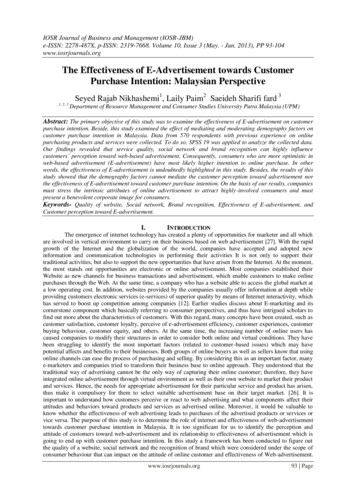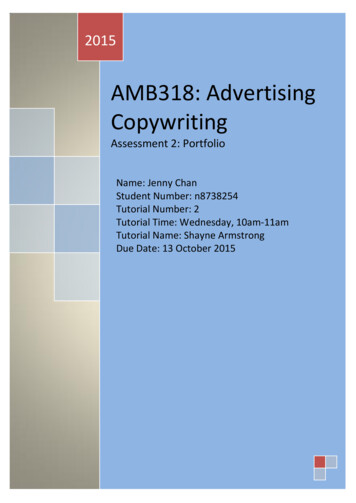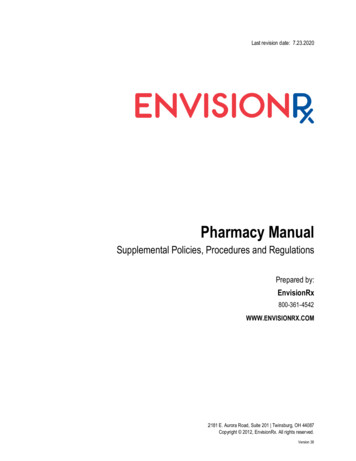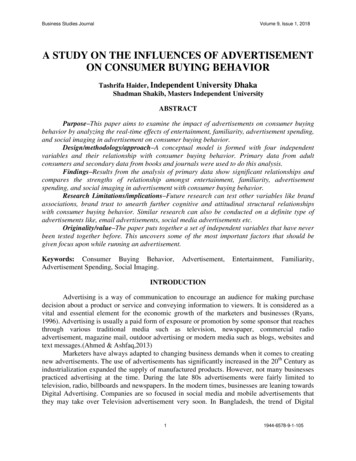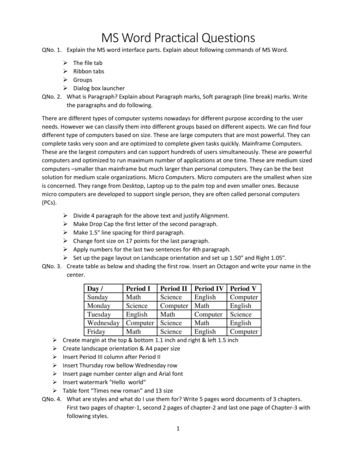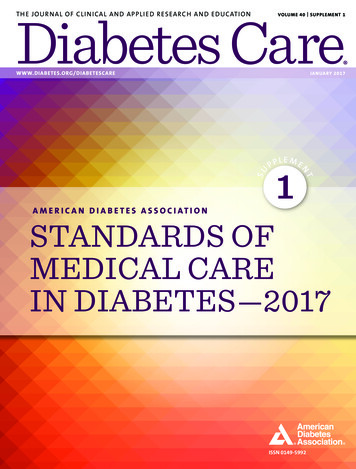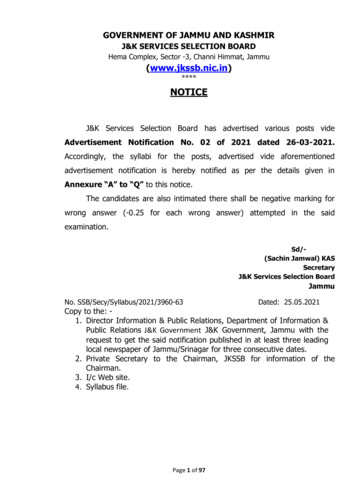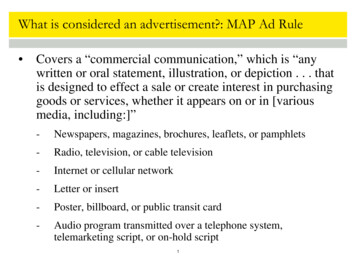
Transcription
What is considered an advertisement?: MAP Ad Rule Covers a “commercial communication,” which is “anywritten or oral statement, illustration, or depiction . . . thatis designed to effect a sale or create interest in purchasinggoods or services, whether it appears on or in [variousmedia, including:]”-Newspapers, magazines, brochures, leaflets, or pamphlets-Radio, television, or cable television-Internet or cellular network-Letter or insert-Poster, billboard, or public transit card-Audio program transmitted over a telephone system,telemarketing script, or on-hold script1
What is considered an advertisement?: State Law State definitions of advertisement vary-Reg. Z definition-MAP Rule definition-SAFE Act Example – “material used or intended to be used to inducethe public to apply for a mortgage loan and includes anyprinted or published materials, audio or visual material,website, or descriptive literature concerning a mortgageloan whether disseminated by direct mail, newspaper,magazine, radio or television broadcast, electronic,billboard or similar display.” What about promotional items?2
Sources of mortgage loan advertisement requirements TILA Regulation Z (12 CFR Part 1026)-HELOC, 1024.16. General open-end plus specific HELOCrequirements. Trigger terms requiring additional disclosures Variable rate disclosures Initial discounted or premium rate disclosures Detailed promotional rate and payment disclosures Balloon payment disclosures Tax implications disclosures Prohibition on use of term “free money” or similarmisleading terms3
Sources of mortgage loan advertisement requirements TILA Regulation Z (12 CFR Part 1026)-Closed-end, 1024.24. General plus mortgage-specificrequirements. Trigger terms requiring additional disclosures Variable rate disclosures Detailed rate and payment disclosures Balloon payment disclosures Tax implications disclosures Seven prohibited acts or practices-Misrepresentations of government endorsement-Misleading advertising of “fixed” rates and payments, rate or paymentcomparisons, use of current lender’s name, claims of debt elimination,use of term “counselor,” and use of foreign language4
Sources of mortgage loan advertisement requirements Mortgage acts and practices advertising rule, Regulation N(12 CFR Part 1014)-Prohibition against material misrepresentations of any mortgagecredit term, including: The amount of interest a customer pays each month and whetherunpaid interest is added to the amount dueAPR, fees and costs, and prepayment penaltiesThe true costs of ancillary products such as credit insuranceThe amount of insurance and taxes required for the loanThe variability of the interest and incorrectly using the term “fixed”Comparisons between rates or payments and rates or payments onlyavailable for a portion of the term of the loan5
Sources of mortgage loan advertisement requirements Mortgage acts and practices advertising rule, cont.-Prohibition against material misrepresentations of any mortgagecredit term: The amount of credit or cash availableThe existence, number, amount, or timing of any minimum orrequired paymentsThe potential and circumstances for defaultThe effectiveness of the loan to consolidate or restructure debtThe association of the loan, program, or provider withgovernmental entities or programsThe source of the customer communicationThe likelihood that the customer will obtain the loan, refinancing,or modification, including if the customer is preapprovedThe availability of counseling6
Sources of mortgage loan advertisement requirements Unfair, deceptive, or abusive act or practice laws-If one regulator or enforcement agency finds the practice unfairor deceptive, then it is likely others will also. Use of calculators or graphs Use of flags Use of depictions of currency Proper disclosure practices Consumer testimonials7
Sources of mortgage loan advertisement requirements State laws-Reg. Z “trigger terms”-Restrictions on use of another lender’s name-Disclaimer re: source of loan information-Disclosure of NMLS Unique ID-Loan comparisons-Licensing disclosures-Use of certain terms – preapproved, prequalified-Name(s) on license(s)8
Hot-button advertisement issues for the CFPB and FTC CFPB’s Naughty List-Potential misrepresentations of government affiliation-Suggesting with a VA loan that the rate being offered was part ofan “economic stimulus plan” that will expire shortly-Potential inaccurate information about interest rates, such asindicating a “fixed” rate for a variable rate loan-Potential misleading statements that consumers with reversemortgages (1) would have “no payments” even though tax andinsurance payments may still be required or (2) will have theopportunity to receive a discount on existing credit card debt-Potential misrepresentations that the consumer is pre-approvedfor or guaranteed specific rates or terms9
Hot-button advertisement issues for the CFPB and FTC FTC Naughty List-Advertisements offering a very low “fixed” mortgage rate,without discussing significant loan terms-Advertisements containing statements, images, symbols, andabbreviations suggesting that an advertiser is affiliated with agovernment agency-Advertisements “guaranteeing” approval and offering very lowmonthly payments, without discussing significant conditions onthese offers10
The risks presented by loan officer websites/social media Status of websites and social media as advertisements Marshall McLuhan stated that “The medium is themessage.” With advertising requirements, the focus is on the messageand not the medium.-Regulation Z—An advertisement is a commercial message in anymedium.-MAP Ad Rule—A commercial communication is a statementdesigned to effect a sale or create an interest in purchasing goodsor services appearing in various formats, including the Internet orany other medium.11
The risks presented by loan officer websites/social media Evaluate how social media is going to be used and applytraditional rules accordingly Take care about re-purposing comments received throughsocial media for commercial communications. Protect against liability for content posted by third parties. Disclosure of “tag lines,” NMLS ID, trigger terms, etc.- Space limitationsLO branding v. licensee branding12
Potential consequences for violating advertisementrequirements Regulation Z advertisement disclosure requirements,1026.16 and 1026.24 (other than 1026.24(i)) Regulation Z prohibited acts or practices with closed-endmortgage advertisements, 1026.24(i) MAP advertising rule, Regulation N, Part 1014 Dodd-Frank UDAAP, state and federal UDAP State laws13
The need for policies and procedures requiring the reviewof all consumer advertisements and marketing materials Companies must have policies and procedures requiring anappropriate and prior review of all consumeradvertisements and marketing materials for legalcompliance. Employee training must emphasize the need for the reviewof all advertisements and marketing materials. Techniques (“best practices”) to provide for appropriatereview with limited compliance resources.-Manuals and guides-Examples of “good” and “bad” ads-Templates14
Trigger terms requiring additional disclosures Variable rate disclosures Initial discounted or premium rate disclosures Detailed promotional rate and payment disclosures Balloon payment disclosures Tax implications disclosures Prohibition on use of term "free money" or similar misleading terms 3
